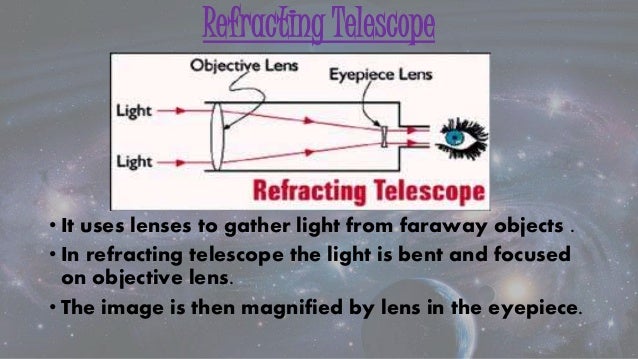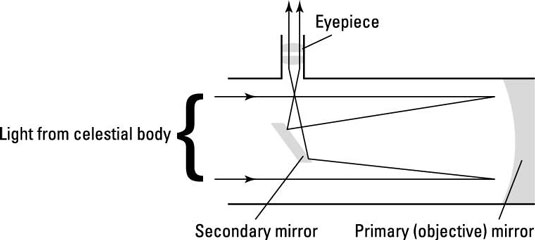They are not subject to chromatic aberration because reflected light does not disperse according to wavelength. The telescope was probably invented in the Netherlands in 1608 when a spectacle-maker Hans Lipperhey put two glass lenses together in a tube effectively creating a refracting telescopeIn 1609 Italian scientist Galileo Galilei heard of this optical device and went on to develop refracting telescopes with magnifications able to observe the solar system in great detail.
Q A How Do Telescopes Work Department Of Physics University Of Illinois At Urbana Champaign
Size and Light Collection.

Reflecting and refracting telescopes. Telescopes are designed to focus light using refracting lenses or reflecting mirrors. For viewing terrestrial and. 3Reflecting telescopes can be made much larger than refracting telescopes.
A refracting telescope or a refractor uses a combination of lenses to produce images of distant objects eg stars and planets that would otherwise not be visible with the human eye. The telescopes have lenses as their optics are known as Refracting Telescopes. Reflecting telescopes have a number of other advantages over refractors.
Reflecting telescopes are sometimes referred to as reflectors. And as only one mirror is required to collect the and focus the light the opposing side can easily be positioned on a surface for extra support. They are both curved but they display different affects on the telescope.
A reflecting telescope is primarily made up of a mirror that bounces off the light onto a smaller focus area. Difference between the refracting telescope and reflecting telescope purpose. Reflecting telescopes use mirrors to gather the light.
Refraction works on the principle that light has different bending properties in different media glasswater air etc. The main difference between a reflecting and refracting telescope lies in how they work to magnify the image by manipulating light. The refracting telescope design was originally used in spy glasses and astronomical telescopes but is also used for long focus camera lenses.
4Reflecting telescopes suffer less from aberrations than refracting telescopes. CBSE 12 Physics 01 Electric Charges and Fields 17 Topics 0101 Electric Charge 0102 Conductors Semiconductors and Insulators. In the refracting telescope light is collected by a 2-element objective lens and brought to focus at F.
A refracting telescope on the other hand focuses light from one end to another using lens. In the Newtonian type of reflector light is reflected by a small flat secondary mirror to the side of the main tube for observation of the image. Although large refracting telescopes were very popular in the second half of the 19th century for most research purposes the refracting telescope has been superseded by the reflecting telescope which.
While the refracting telescope uses a lens that you can see through the reflecting telescope a mirror. The three main positives of a Reflecting Telescope are. Every one of us has once in our lifetime read or studied the principle of refraction.
In a Refracting telescope we have a pair of lenses that focus the light and the objects appear closer than they really are. On the other hand an refracting telescope has a lens as its objective lens to form an image. When youre ready to invest in a stargazing telescope start by looking at the different models of telescope tube the bits with the optics in.
This is why they require to be manipulated with precision and attention. You can find quite a few different designs. The principal optical element or objective of a reflecting telescope is a mirror.
Reflecting vs Refracting Telescopes. Also the telescope tube of a reflector is shorter than that of a refractor of the same diameter which reduces the cost of the tube. This is basically a type of telescope that is closely related to Newtonian telescope it belongs to a larger group of catoptrics telescopes along with Cassegrain telescopes Crossed Dragone telescopes Gregorian telescopes Wolter telescopes and others.
Lets recall it here. The difference between Reflecting and Refracting Telescopes is that a reflecting telescope has a single or a combination of curved mirrors in order to reflect the light rays and form an image. For example a mirror frequently exposed to this harsh environment could be less reflective within years or put it in a different way its ability to.
1Reflecting telescopes use mirrors while refracting telescopes use lenses. Helpful for cbse class 12 physics chapter 9 ray optics and optical instruments. This size is about the limit for optical glass lenses.
Reflector telescopes are mainly open telescopes meaning that the mirrors are exposed to the air humidity and dust. Refracting Telescopes use a glass lens to cause the convergence of the light. As mirrors are easier to build compared to lenses it is possible to make them larger and more durable.
2Refracting telescopes require a much purer material than reflecting telescopes. Learn reflecting telescope its working types advantages of reflecting over refracting telescopes. Reflecting Telescopes use a concave primary mirror to collect light and form an image.
The largest refracting telescope is the 1-m 40-in telescope-built over a century ago-at Yerkes Observatory. Advantages of Reflecting Telescope. Reflecting telescopes use mirrors concave or convex to direct incoming light to converge to a point.
Refracting telescopes use lenses. Size and Light Collection. A simple refracting telescope is made up of two lenses which are called the objective and the eyepiece.
To know which one is best for you the functionality or purpose of the telescope comes into play. The smallest telescopes are often designed to use lenses but in most cases mirrors are more affordable when using larger telescopes.

Refracting And Reflecting Telescope

Reflecting Vs Refracting Stargazing Telescopes Dummies

How Do Telescopes Work Nasa Space Place Nasa Science For Kids

Reflecting Vs Refracting Telescopes Which Is Better Astrojunkies Com